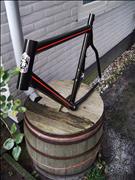 Page 1 of 2 Page 1 of 2
|
| |
| |
|
|
| Model: | SC1 |
| Brand: | Vitus |
| Category: | Mountain Bike |
| Years: | N/A |
| Country: | France |
| Production: | Unknown |
| Sold As: | Unknown |
| Material: | - - - - |
| Construction: | - - - - |
| Drivetrain: | - - - - |
| Wheel Size: | - - - - |
| Added By: | Elev12K on 12/30/10 |
| Updated By: | Elev12K on 12/30/10 |
Frame Example Photos
This Frame Model has 1 Frame Example with additional photos. Choose from the options below to view them.
 View First Photo from each Example
 View All Frame Example Photos
|
|
| Model General Information |
| Welded aluminium construction. Only bosses and dropouts are glued and bolted.
- Anodished finishing - Brake and gear cables run slotted under the top- or downtube. Under downtube hidden by a cover. - Squarish top- and downtube - For canti brakes
A little bit more affordable than the CL1 back in the day.
Original fork is the bonded aluminum fork. Same as with the CL1. |
 |
| Primary Example: | Vitus SC1 |
| Years: | N/A | Sold As: | Unknown |
| Bottom Bracket: | | Brake Mounting: | |
| Lug Style: | | Brake Guides: | |
| Fork Style: | | Seat Stays: | |
| Fork Crown Style: | | Main Tubing: | |
| Rear Dropouts: | | Color(s): | |
|
